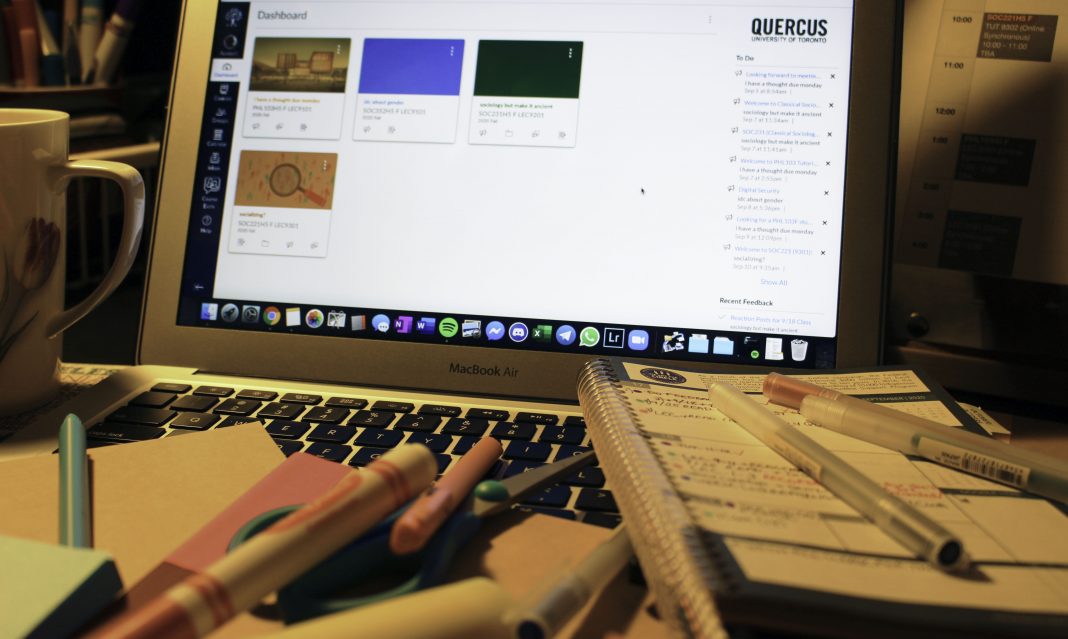In response to the Covid-19 outbreak, the University of Toronto has cancelled most in-person classes on all three of its campuses. It has been two weeks since the school began conducting its lectures online and students, as well as faculty, have mixed responses regarding their virtual classes.
One of the main concerns regarding the online university experience is tuition fees. University tuition has, contrary to popular belief, been on the rise despite completely being an e-learning experience. With Canada losing two million jobs in April and only regaining 55 per cent of those lost, students believe that as a result of employment changes in the community, the net tuition should be cut down. Another point being made is that the online learning experience is not the educational experience students were expecting. Many students believe that online learning interactions and communication are not equivalent to those of the classroom experience. Students have taken the initiative to create numerous online petitions with hopes of impacting tuition fees, but none have proven successful.
Another hardship faced with virtual learning is one that directly impacts international students—time zones. Many international students struggle to familiarize themselves with the different learning conditions, and balance them with their new daily schedules and individual timezones. To attend their virtual classes in real-time, they must make a schedule according to Eastern Time. There is, of course, the option of watching recorded lectures, but this does not necessarily provide them with the same experience as the live lecture, as they are not able to ask questions while following along. Moreover, some courses require the live attendance of students for their participation grade. However, the situation for international students has not been an entirely negative experience. Some students have found an appropriate balance between their timezones and their classes to have a “regular” school day.
Ahmad Kubbar, a second-year UTM undergraduate student specializing in biotechnology, feels that “online learning is the perfect opportunity to go back” and see his family while also continuing his education. Kubbar is currently trying to balance a seven-hour time difference as he completes his second year in Qatar. Although he finds that many of his classes are “a lot later” than he “is used to,” he has managed to organize his “schedule in a way that made it very easy and doable to study from Qatar.” That being said, Kubbar does not think he can “sustain online learning for much longer” as he finds it more challenging to “concentrate and retain all the information,” an issue that was not prominent with in-person classes.
Ahmed El-Saifi, also a second-year international student specializing in biotechnology, shared a similar opinion to Kubbar. El-Saifi’s decision to partake in a remote learning experience was fueled by his enthusiasm to “connect with family and friends while still pursuing his education.” El-Saifi is struggling to balance his seven-hour time difference from his home in Jordan. He finds it particularly “confusing when it comes to deadlines and lecture times.”
Yet, although El-Saifi misses the “social interactions” he was used to with in-person classes, he believes he can sustain the drawbacks to remote learning to “prevent the spread of the virus.” He also believes that “despite the rapid transition, UTM has swiftly adapted to online learning.” Although this comes with its own challenges, he knows that the UTM community is doing its best to make the transition as smooth as possible.
Although the transition to online learning has been challenging for international students, local UTM students are also finding it difficult to cope with the change. When students are on campus, they are less likely to miss a class due to the rapid Wi-Fi connection and since they are on-campus. However, with online learning students must take their education in their own hands, and account for novel factors. With the number of users trying to access these online tools, the Wi-Fi connection is becoming increasingly unstable as internet providers struggle to keep up with increased demand. Additionally, when classes occur in person, students are motivated to attend class on time and be surrounded by like-minded individuals. With remote learning, home and school life have been merged quite abruptly, and students are finding that they are more distracted at home, making it challenging for them to understand and stay focused on their studies.
Andrea Aghasi, a fifth-year undergraduate student majoring in psychology, elaborated that she has decided to go with remote learning because she is “not completely comfortable with being in public spaces” amid the pandemic. Aghasi was “hesitant” to attend in-person classes because she felt as though “some individuals will be unable to social distance or comply with wearing PPEs.” That being said, Aghasi has experienced her own set of obstacles with online learning. The most prominent complication Aghasi has faced is being able to “comply” with her schedule as she “often forgets about lectures and/or assessments” from being “home all day.” Moreover, she is also finding it “difficult to pay attention” to lectures with distractions at home, such as her dog and family.
Nonetheless, Aghasi believes that she will be able to “sustain online learning until the end of the year.” She knows she will “gradually become accustomed” to online learning, knowing she is “safe at home while still being able to learn.” This sense of safety and solace gives her “confidence” in her ability to learn from the comfort of her home.
Although online learning has proven to have many complications for both students and faculty, many choose to look at the positive effect of online learning around the world. The transition between in-class to online learning was abrupt and unexpected. However, both students and faculty are gradually becoming more accustomed to their circumstances. Moreover, UTM has continuously adapted to the challenges brought their way. The community has worked diligently to create both an encouraging and safe atmosphere to ensure student success despite the complications and disruptions caused by the pandemic.



